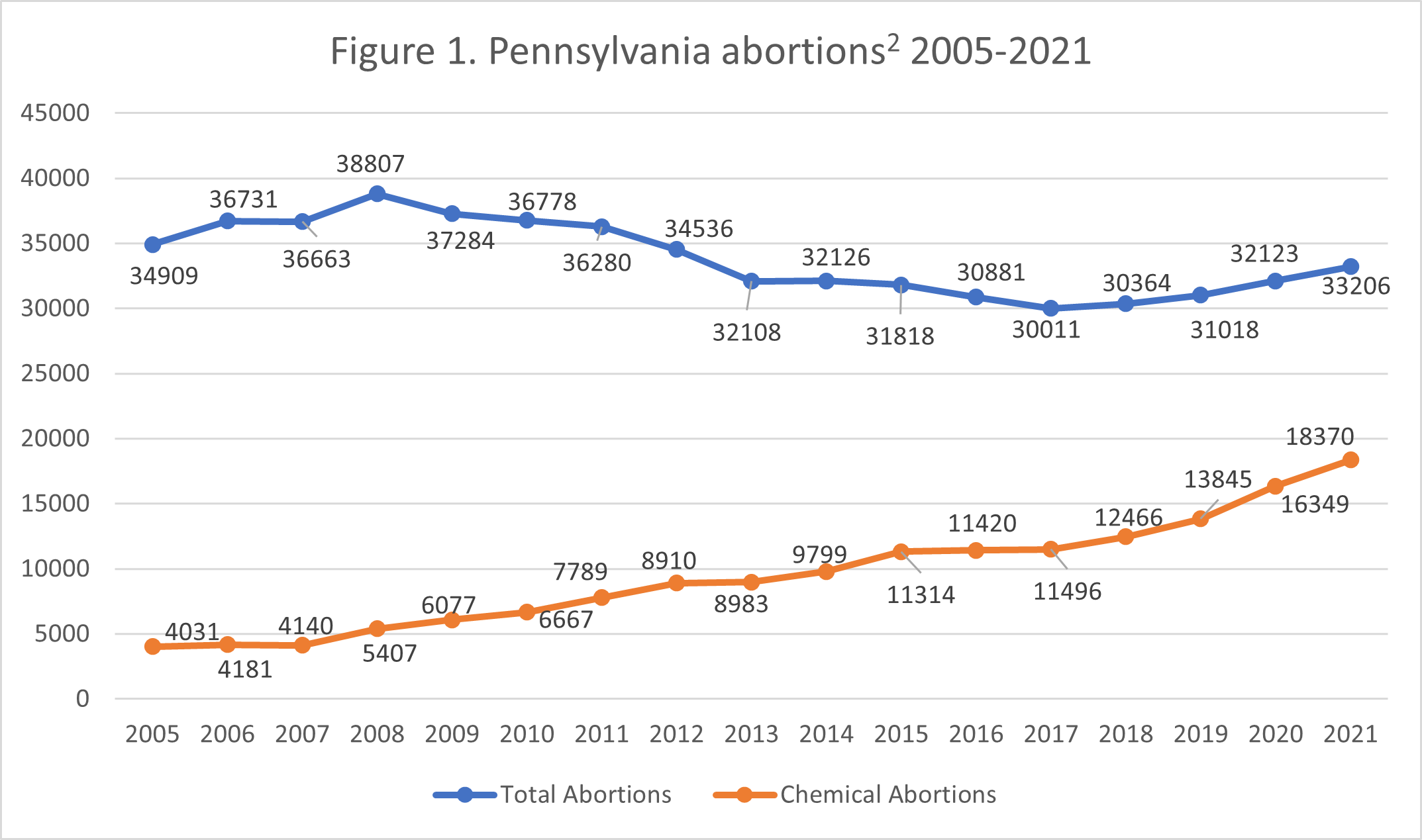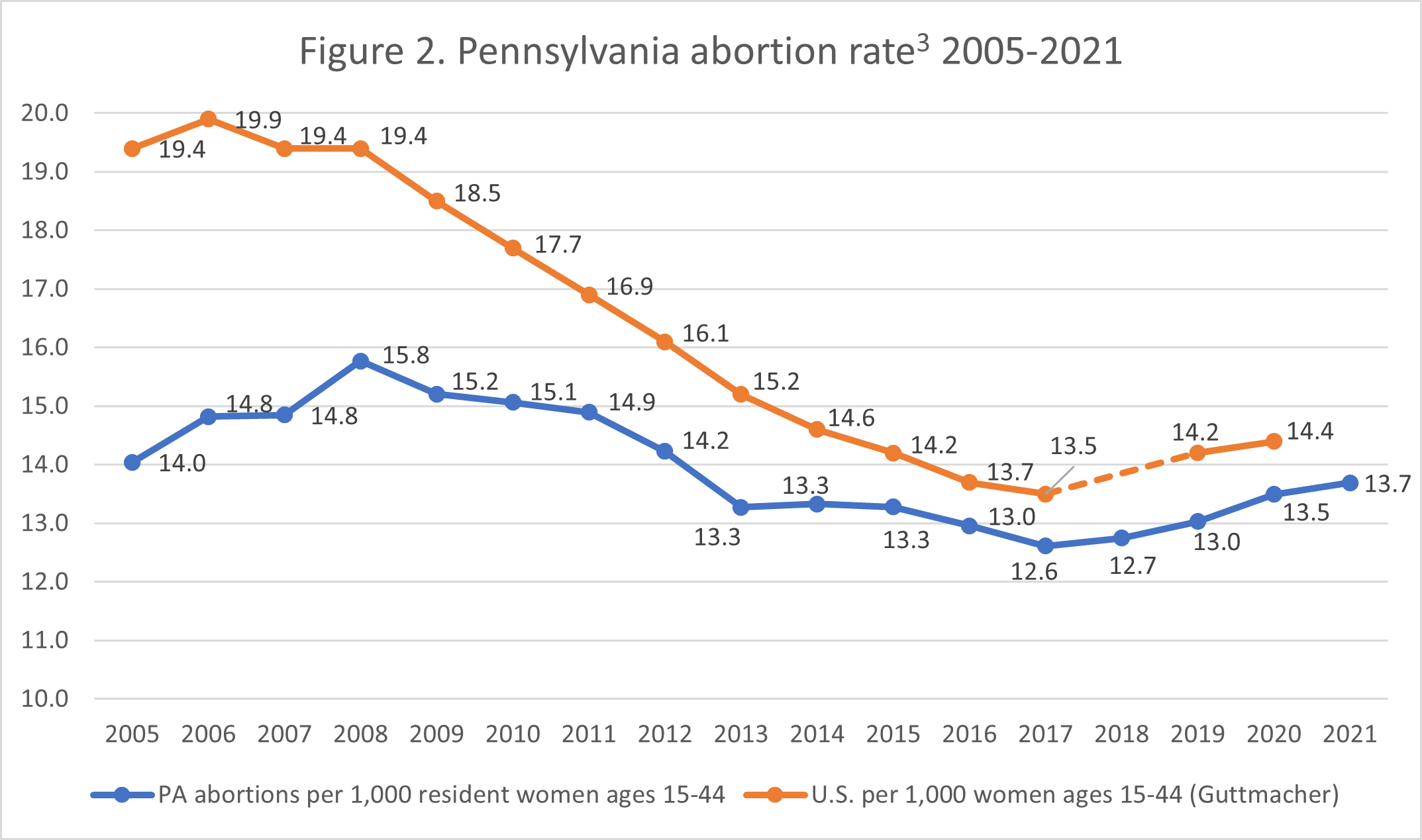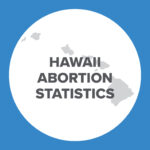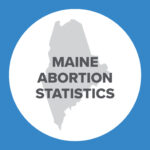Abortion Reporting: Pennsylvania (2021)
Pennsylvania’s 2021 abortion report was published online by the Pennsylvania Department of Health in December 2022. The report shows that abortions increased from the previous year.
Statistics and Changes in Pennsylvania Abortions, 2020-2021

The report does not include information on Planned Parenthood’s Pennsylvania abortion market share.
Abortion Totals and Trends
There were 33,206 abortions reported in Pennsylvania in 2021, an increase of three percent from 2020. Chemical abortions increased by 12 percent to make up over half (55 percent) of the state total (Fig. 1). The Charlotte Lozier Institute (CLI) estimates that Pennsylvania’s abortion rate rose three percent to 13.7 abortions per 1,000 women ages 15-44 from 13.3 in 2020.
State Report Summary
In 2021, 93 percent of Pennsylvania abortions were performed on resident women, while seven percent were performed on women from other states, including three percent on women from Delaware, two percent on women from Ohio, and one percent each on New Jersey and West Virginia residents. Another 0.5 percent were performed on women from other states.
Eight percent of Pennsylvania abortions were performed on young women under the age of 20, with two percent on girls under the age of 18. Twenty-seven percent of the abortions were obtained by women ages 20 to 24, and 29 percent were performed on women ages 25 to 29. Thirty-two percent of the abortions were performed on women in their thirties. Four percent of Pennsylvania abortions were obtained by women ages 40 and above.
Forty-five percent of Pennsylvania abortions were performed on white women, and 44 percent were on African American women. CLI estimates that Pennsylvania’s African American abortion rate, 43 abortions per 1,000 women ages 15 to 44, was 5.3 times higher than the white abortion rate of eight abortions per 1,000 women ages 15 to 44. Abortions on Asian or Pacific Islander women accounted for three percent of the total, while four percent of the abortions were performed on women of multiple races. One percent of the abortions were performed on women of other races and three percent were on women of unknown race. Eighty-eight percent of the abortions were on non-Hispanic women and 12 percent were on Hispanic women.
Eighty-eight percent of Pennsylvania abortions were obtained by unmarried women, compared to 11 percent performed on married women. Under one percent were performed on women of unknown marital status. Thirty-seven percent of the abortions were performed on women with no previous live births, and 52 percent were on women with no prior abortions. Twenty-six percent of Pennsylvania abortions were obtained by women with one prior live birth, and 38 percent were on women with two or more live births. Twenty-four percent of the abortions were performed on women with one prior abortion, and 24 percent were on women with more than one prior abortion.
Over half the abortions reported in 2021 were chemical (55 percent). Forty percent of the abortions were performed via suction curettage, and four percent were dilation and evacuation procedures. There were four abortions performed using sharp curettage. Additionally, there were three hysterectomy or hysterotomy abortions and three intrauterine instillation abortions, and 56 abortions performed using some other means.
More than two-thirds of the abortions, 68 percent, occurred at eight weeks of gestation or earlier. Sixteen percent were reported between nine and 10 weeks of gestation, and six percent were performed between 11 and 12 weeks. Four percent occurred between 13 and 14 weeks, three percent were performed between 15 and 17 weeks, and two percent occurred from 18 to 20 weeks of gestation. There were 427 abortions (1.3 percent of the total) performed between 21 and 23 weeks of gestation; no abortions were reported at 24 weeks or later.
Abortion Complications
There were five abortion complications reported at the time of the procedure, and 159 pregnancies complicated by pre-existing medical conditions. The report does not indicate what these pre-existing conditions were, but Pennsylvania law lists as possible examples hydatid mole, endocervical polyp, malignancies, radiation exposure, genetic indications, psychological indications, rape, incest, and rubella disease.
Separately, there were 322 abortion complications reported subsequent to the abortion procedure, an increase of 35 percent from 2020. Over half (56 percent) of these resulted from chemical abortion, while 27 percent were caused by suction curettage procedures and seven percent by dilation and evacuation abortions. Six percent of the complications resulted from sharp curettage procedures despite only four being performed in 2021; it is possible that some complications were caused by abortions performed the previous year or in other states. Four percent of the complications were caused by other or unknown abortion methods. Just under three-quarters (74 percent) of the complications were retained products of conception, 13 percent were bleeding, and six percent were infections. Seven percent were some other types of complication.1
State Ranking
In CLI’s 2016 analysis of abortion reporting across the 50 states, New York City, and the District of Columbia, Pennsylvania’s reporting tied for 23rd best. Pennsylvania could report data from the quarterly abortion reports filed by facilities that receive public funding per Pennsylvania law.


- Statistics on abortion complications reported here represent a minimal number of deaths and complications, as this data is collected in a non-systematic and non-verifiable way. As such, this data cannot be used to calculate either an accurate abortion mortality rate or an accurate abortion complication rate for the state.
- The annual totals of chemical abortions performed in Pennsylvania in 2005, 2006, and 2007 were taken from abortion surveillance reports published by the Centers for Disease Control and Prevention because they were not reported by the state for these years.
- Rates were calculated by CLI using the following formula: (total number of abortions performed in Pennsylvania ÷ number of resident women ages 15-44) x 1,000. Rates may differ slightly from previous CLI articles due to revised population estimates. Population estimates were obtained from CDC WONDER. Estimates for 2005-2009 are intercensal estimates of the July 1 resident population. Estimates for 2010-2019 are Vintage 2020 postcensal estimates of the July 1 resident population. Estimates for 2020-2021 are Vintage 2021 postcensal estimates of the July 1 resident population. Estimates were produced by the U.S. Census Bureau and the National Center for Health Statistics.
Click here to view reporting from:2023202220202019201820172016























